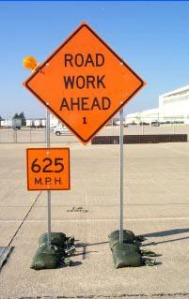How do the British and U.S. cultures differ? Read the road signs and you can learn a lot.
Ice Badger called my attention to the issue in a comment about calling cats. I admit, the link between the two topics isn’t obvious, but it made sense at the time. So fasten your seatbelt, please, because we’re going to investigate road signs and I hate driving while someone’s bouncing around loose in the back seat.
A few weeks ago, Wild Thing and I drove past a temporary road closure sign on the slip road onto the motorway. I’ll translate that: The sign was about repairs and it was beside the freeway entrance.
Wild Thing was driving, so she asked, “What did it say?”

Damn near relevant photo, from Wikimedia. An American road sign–apparently part of a Highway Department test of dangerous signs. The edge of the sign went through the windshield in a test crash. And the speed limit isn’t really 625 mph, it’s 62.5. Why would anyone bother with .5 mph in a speed limit? Don’t ask.
Signs announcing repairs are so wordy here that we’ve stopped trying to read them while we’re driving. They say things like, “We’re terribly sorry to announce that this road will be closed between the hours of 7 a.m. and 4 p.m. on the fifth day of March in the year of our lord 2016 for repairs. We regret the inconvenience but the work is necessary for the smooth functioning of the United Kingdom’s infrastructure.”
I exaggerate only slightly. The repair work is done county by county, so they wouldn’t say “United Kingdom,” they’d name the county. But the fine points don’t matter. If you’re going to write a 500-word essay on a movable sign, you have to use small print, and that in turn means that drivers can’t begin to read it until they’re on top of it. And then they’re past it and they’ve only gotten as far as “terribly.”
When I’m the passenger (which isn’t often; I tend to get carsick and do better when I drive), I try to pick dates or times out of a sea of letters. If I see “p.m.” after the first number, it’s overnight construction and I can toss the road closure into the mental drawer marked “Stuff I don’t need to know” unless we’re planning some late-night driving. If I can’t pick out p.m, I have to shove it into the drawer labeled “Things I don’t know much about but that worry me.” In an odd way that’s good, since it’s overstuffed and this particular worry won’t get much individual attention.
On the other hand, if the road’s going to be closed for days at a stretch, I might actually need to know that and I won’t. So it’s worth a bit of worry. Maybe I’ll lay it neatly on the top layer.
To all of that, the Highway Department (which isn’t called that, I’m sure—I’m importing an American term) says, “Tough.”
Or “We’re terribly sorry, but this is the way we do things here.”
What would an American sign say in a similar situation? “Road Closed, March 5, 7 a.m. – 4 p.m.” Or something along those lines. In large print.
It all goes to reinforce national stereotypes, I’m afraid: Americans are blunt and to the point. Or rude, if you like. Road closed. No apologies and no explanations. The British say about themselves that if someone stands on their foot, they’ll–the person whose foot is being stood on–will apologize, so their signs first apologize and then throw in a bunch of extra words to soften the blow.
